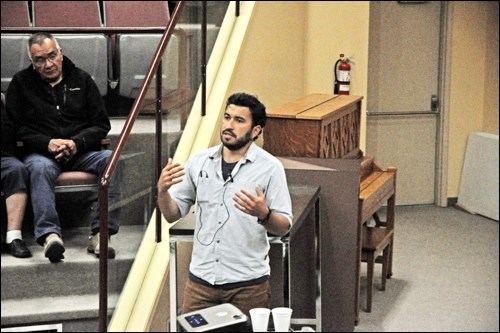An independent analysis of the Husky oil spill into the North Saskatchewan River painted a grim picture of the state of the river.
The “independent primary assessment” was shared by consultant Ricardo Segovia of E-Tech International and Resurgence Environmental. The survey was backed by a number of groups including Idle No More, the Council of Canadians, the Assembly of Manitoba Chiefs, the National Aboriginal People’s Circle and the Public Service Alliance of Canada (Prairie Region) among others.
The report included findings that were highly critical of Husky Oil. A summary of the findings was posted at the Idle No More website and includes the following:
Husky was criticized for its delayed reaction to the July 20 oil spill, with the report pointing to the reported 14-hour delay in reaction from the time the oil began leaking.
Husky was slammed for a lack of information about both its data and its cleanup efforts.
The report also pointed to E-Tech/Resurgence samples taken at Tobey Nollet Bridge, near the spill site, and at Cecil Ferry past Prince Albert. According to the report, both showed similar results, with the sampling showing river contamination reaching as far away as the Cecil Ferry location.
The report also accused Husky of failing to inform the public about the risks associated with evaporating BTEX-group chemicals (benzene, toluene, ethylbenzene and xylene) and other compounds during the first 48 hours after the spill. They stated Husky should have warned residents to stay away from the river immediately after the spill.
The E-tech assessment states the BTEX chemicals and PAHs (polycyclic aromatic hydrocarbons) cause cancer.
In his presentation Segovia expressed continued concerns about the oil having sunk to the bottom of the river and ending up in the sediment.
For that reason, he said people living near the river ought to use carbon filters on their showers and taps from now on, just to be on the safe side.
“I’m still going to buy a carbon filter for my house,” said Segovia, who added that for the next two years the river water should be “tested all the time to see what’s going in the intakes.”
There were about 40 people on hand at the North Battleford Public Library to see Segovia’s presentation, including several environmental activists from the area. Many at the meeting vented disgust with Husky and with government officials over the oil spill.
One of those at the meeting, Reid Stewart, called for people to be held accountable for the oil spill and called for tribunals where “Brad Wall and Husky Oil should be put on trial for their crimes.”
Attending the meeting was Mayor Ian Hamilton, who himself was put on the hot seat in answering several questions about the oil spill and the response.
He said a command centre was set up to deal with the response and made clear the City had concentrated on making sure the water supply was safe.
“We were able to do that because we were able to shut off our service water intakes in the river prior to the oil spill reaching the city,” said Hamilton.
Hamilton also reiterated that even though the Water Security Agency has given the authorization to draw water from the river again, the City was still proceeding with caution and would not be opening the intakes until a pre-filtration system is in place.
Hamilton also noted all the direct costs to the City were being reimbursed by Husky. He confirmed the City had been in direct contact with Husky officials and had received a $3.5 million payment from Husky to deal with initial costs of the spill response.



